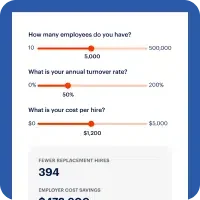In the past five years, the average hospital turned over 106.6% of its workforce.1
The global workforce has been reshaped over the past few years, including the healthcare industry. According to the 2024 NSI National Healthcare Retention & RN Staffing Report, the hospital turnover rate stands at 20.7%, a 2.0% decrease from 2022, and Registered Nurse turnover is recorded at 18.4%, a 4.1% decrease.2
Although employee exits have recently decreased, labor shortages, employee burnout and retirement have kept hospital turnover rates elevated. In the past five years, hospitals have turned over 106.6% of their staff.3 Further data shows that voluntary terminations accounted for 95.4% of all hospital separations.4 For 2024, hospitals aim to decrease turnover by 3.0%.5
According to the NSI Report, time-to-fill for Registered Nurse positions decreased across the board, but it still takes about three months to hire an experienced RN and many hospitals indicate they can’t find experienced RNs. Not only is the healthcare industry experiencing high turnover rates, but recruiting is also very difficult. Medical/surgical Registered Nurses were the most difficult to hire, taking 80 to 109 days to fill, with the average being 94 days.6
The average cost of turnover for a bedside Registered Nurse is $56,300, costing the average hospital between $3.9 and $5.8 million per year. With each percentage point increase or decrease in the Registered Nurse turnover rate, hospitals will lose or save $262,500 per year.7
The Registered Nurse vacancy rate within hospitals currently stands at 9.9% nationally, which is 5.8% lower than last year.1 The U.S. Bureau of Labor Statistics estimates the employment of Registered Nurses and healthcare practitioners in the diagnosis and treatment fields will grow faster than the average for all other occupations between 2022 and 2032.8
As labor gaps grow, it’s important to identify the areas within the healthcare industry that are particularly susceptible to turnover and learn what can be done to slow rates.
Retention Patterns in Healthcare Based on 2024 Data
Turnover rates in long-term care facilities like nursing homes are significantly higher than in hospitals. For example, According to the Long-Term Care Community Coalition (LTCCC), the average nursing home reported a nursing staff turnover rate of 53.3% and a registered nurse turnover of 51.9%. 9
Nursing homes often struggle with lower staffing levels, leading to a heavier workload and increased stress among the staff. Additionally, the compensation and benefits in these settings are typically less competitive compared to hospitals, which offer more robust pay scales and career advancement opportunities. The emotional toll of working closely with elderly and chronically ill patients who may not significantly improve also contributes to burnout. These challenging conditions drive many healthcare professionals to seek employment in hospital settings, where they perceive better support and job satisfaction.
2024 Turnover by Position10
- Registered Nurses: 18.4%
- Certified Nursing Assistant (CNA): 41.8%
- Physician Assistant (PA): 11.1%
- Physical Therapist: 12.1%
- Medical Technologist: 15.9%
- Pharmacist: 10.7%
- Radiologic Technologist: 15.2%
- Patient Care Tech (PCT): 36.3%
Based on the data above, Certified Nursing Assistants (CNAs) face the highest turnover rates in healthcare due to a combination of factors that differentiate their experience from Registered Nurses (RNs) and other healthcare professionals.
Primarily, CNAs typically earn lower wages despite performing physically demanding and emotionally taxing work. This economic factor, coupled with limited career advancement opportunities, contributes significantly to job dissatisfaction. Moreover, CNAs usually have higher patient loads and less autonomy in their roles, which can lead to increased stress and burnout.
Patient Care Technicians (PCTs) also experience high turnover rates in healthcare, similar to Certified Nursing Assistants (CNAs). PCTs are vital frontline workers who perform essential duties, from monitoring vital signs to assisting with daily activities.
Despite their critical role, PCTs often face low compensation, demanding work conditions, and high emotional stress, which contribute to job dissatisfaction. The physically strenuous nature of their duties, combined with exposure to patient suffering and high-stress environments, can lead to burnout.
With limited opportunities for professional growth or increased pay within the role, many PCTs leave for better prospects or more sustainable work conditions in other healthcare positions or industries.
By Demographic
There are a variety of factors that come into play when trying to discern turnover reasons. Location and position are factors, but additionally, age may play a role in turnover rates, especially for primary care physicians in rural areas.
By Tenure
- 30.2% of all new hires left within a year, accounting for 40.4% of all healthcare turnover.11
- 62.2% of employees who left spent less than two years in their position.12
By Facility
- The current turnover rate for hospitals is 20.7%, down 2.0% from the previous year.13
- South-East U.S. (AL, FL, GA, KY, MS, NC, SC, TN, VA & WV) has the highest regional turnover at 22.2%.14
North-Central U.S. (IA, ND, NE, OH, SD, WI, WY, IL, IN, KS, MI, MN, MO & MT) has the lowest regional turnover at 19.0%.15

Hardest Positions to Fill in Healthcare
Long periods of unfilled positions contribute to high turnover rates. And, while the nursing shortage has received a lot of media attention, it’s getting even more difficult to recruit.
According to the 2024 RN Staffing Report, here’s how long it takes to hire different Registered Nurse specialties.
- Medical/surgical RN – 94 days
- Critical Care RN – 83 days
- Operating Room RN – 92 days
- Progressive Care Unit RN – 90 days
- Telemetry RN – 90 days
- Emergency Room RN – 82 days
- Labor and Delivery – 73 days
The longer a job goes unfilled, the more it impacts a hospital’s bottom line, and clinical personnel aren’t the only difficult-to-fill positions. For many physicians’ offices, this can be detrimental to quality care and customer service.
The Cost of Turnover and Staffing Gaps
There are many factors that go into the true cost of turnover. For example, when a healthcare professional leaves, the hospital must account for:
- Staffing costs (e.g., overtime payouts, agency nurses, travel nurses)
- Continuity of care
- Training costs
- Staff workloads
- Accident rates
- Absenteeism
- Medical staff dissatisfaction
Not to mention, programs like those dedicated to mentorship and professional development worsen as the staff tenure decreases.
It can cost an employer an average of between six and nine months of an employee’s annual salary to replace them, according to the Society for Human Resource Management16, and it can cost as much as 200% of the employee’s annual pay to replace a specialized healthcare professional.
Why Turnover Is a Problem in the Healthcare Industry
Identifying why turnover is such a problem in the healthcare industry is the first step to resolving it. Common issues that perpetuate turnover numbers may include the following:
- Lack of workplace engagement
- Burnout symptoms of stress, anxiety, depression and sleep disturbances
- A tight labor market and stiff competition for talent
- Baby boomers reaching retirement age and leaving vacancies
- Job hoppers
A key to solving the turnover problem lies in the ability to improve workplace engagement. Increased employee engagement can help to attract top talent in a competitive landscape and keep current employees happy, minimizing the risk of staff considering other job opportunities.
Recruiting, Engaging and Retaining Employees
The trifecta of recruiting, retaining and engaging employees is helpful to the success of multiple business objectives in healthcare.
Improve Retention Strategies
While turnover rates in the healthcare industry are notoriously high, many hospitals have implemented retention strategies but about 25% of hospitals currently have not tied them to measurable goals.17 Finding ways to increase tenure at your facility can help ease staffing gaps, improve patient care and evolve programs that maintain a well-trained arsenal of staff at your facility.
Focus on Employee Experience
We can all agree that bedside manner is an important component of a healthcare provider’s job. But, have you considered how your facility treats your staff? Across the board, HR departments are starting to realize that employee experience is a huge part of keeping employees engaged and happy in the workplace.
To offer an enhanced employee experience, facilities must get to the core of what their workforce wants from an employer, whether it be financial wellness, workplace flexibility or otherwise. Listening to employee feedback is a key ingredient for successful recruiting, retention and employee engagement.
Find Leverage in a Competitive Market
In today’s tight labor market, hospitals must differentiate themselves to attract and retain top talent. A survey conducted by The Harris Poll found that 73% of healthcare workers say it is important to them that their employer provides tools and resources to help them manage financial stress.18 Empowering employees with access to their earned pay before regularly scheduled pay cycles can help attract and retain top talent.
A solution to giving employees what they want can be found in on-demand pay through a platform like DailyPay. DailyPay is a benefit that gives your employees more control over when and how they access their pay. DailyPay’s solution is designed to help alleviate financial burdens that may affect employees while simultaneously empowering them to make smarter financial decisions.
DailyPay is a viable and cost-effective benefit for many organizations. Not only are daily pay solutions non-disruptive to your current payroll process, they offer creative ways to inspire, motivate and fulfill employees.
Companies who offer on-demand pay see significant benefits:
- 71% of healthcare workers would be more likely to remain at a job if their employer offered an on-demand pay benefit than if they didn’t offer one.19
- 65% of healthcare workers say being able to track their earned wages on a daily basis would help alleviate financial stress.20
- 48% of users say they are more motivated to remain with their current employer because they offer DailyPay.21
- 67% of users say DailyPay has helped them reduce financial stress.22
With DailyPay, healthcare providers can care for their employees the way they expect their employees to care for their patients. In a new job market where employees hold more power than ever before – with more job choices, work options and revenue streams – employers must innovate and think of creative ways to attract and retain today’s top talent. On-demand pay is a customizable employee benefit healthcare workers can use to achieve greater financial wellness, and in return employers foster a more attractive, engaged and productive workforce.
To learn more about how DailyPay can help you create the healthcare staff of the future, schedule a demo where we’ll walk you through all the powerful benefits today’s employees expect.
1 2023 NSI National Healthcare Retention & RN Staffing Report:DailyPay, 2020
2 2024 NSI National Healthcare Retention & RN Staffing Report:DailyPay, 2020
3 2024 NSI National Healthcare Retention & RN Staffing Report:DailyPay, 2020
4 2024 NSI National Healthcare Retention & RN Staffing Report:DailyPay, 2020
5 2025 NSI National Healthcare Retention & RN Staffing Report:DailyPay, 2020
6 2024 NSI National Healthcare Retention & RN Staffing Report:DailyPay, 2020
7 2024 NSI National Healthcare Retention & RN Staffing Report:DailyPay, 2020
8 BLS, 2023:DailyPay, 2020
9 IntelyCare: How to Reduce Nurse Turnover at Your Facility, 2024:DailyPay, 2020
10 2024 NSI National Healthcare Retention & RN Staffing Report:DailyPay, 2020
11 2024 NSI National Healthcare Retention & RN Staffing Report:DailyPay, 2020
12 2024 NSI National Healthcare Retention & RN Staffing Report:DailyPay, 2020
13 2024 NSI National Healthcare Retention & RN Staffing Report:DailyPay, 2020
14 2024 NSI National Healthcare Retention & RN Staffing Report:DailyPay, 2020
15 2024 NSI National Healthcare Retention & RN Staffing Report:DailyPay, 2020
16 The Real Cost of Healthcare Staff Turnover, March 2023:DailyPay, 2020
17 2024 NSI National Healthcare Retention & RN Staffing Report:DailyPay, 2020
18 Harris Poll survey commissioned by IntelyCare and DailyPay, November 2022:DailyPay, 2020
19 Harris Poll survey commissioned by IntelyCare and DailyPay, November 2022:DailyPay, 2020
20 Harris Poll survey commissioned by IntelyCare and DailyPay, November 2022:DailyPay, 2020
21 DailyPay User Survey, November 2022:DailyPay, 2020
22 DailyPay User Survey, November 2022:DailyPay, 2020













